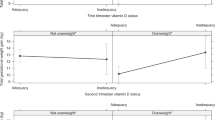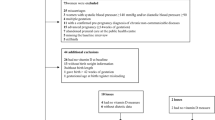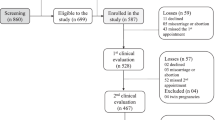Abstract
Obesity increases the risk of low 25-hydroxyvitamin D (25(OH)D) concentrations and gestational diabetes (GDM). We explored whether the association between GDM and change in 25(OH)D concentrations measured in the first (7–18 wk) and second (20–27 wk) trimesters of pregnancy is dependent on maternal BMI. The study was a prospective study of 219 women with BMI of ≥30 kg/m2, a history of GDM, or both. The participants were stratified by first-trimester BMI: BMI of <25.0, 25.0–29.9, 30.0–34.9, and ≥35 kg/m2. In the BMI group ≥35 kg/m2, those who did not develop GDM during the follow-up showed higher increase in serum 25(OH)D concentrations compared with women who developed GDM (43.2 vs. 11.5%; P < 0.001). No associations between 25(OH)D concentrations and GDM were observed in other BMI groups. These findings give an important aspect of the role of maternal body size in the association between vitamin D and GDM in high-risk women.
This is a preview of subscription content, access via your institution
Access options
Subscribe to this journal
Receive 12 print issues and online access
$259.00 per year
only $21.58 per issue
Buy this article
- Purchase on Springer Link
- Instant access to full article PDF
Prices may be subject to local taxes which are calculated during checkout

Similar content being viewed by others
References
Buchanan TA, Xiang A, Kjos SL, Watanabe R. What is gestational diabetes? Diabetes Care. 2007;30(Suppl 2):S105–S11.
Reece EA, Leguizamon G, Wiznitzer A. Gestational diabetes: the need for a common ground. Lancet. 2009;373(9677):1789–97.
Parlea L, Bromberg IL, Feig DS, Vieth R, Merman E, Lipscombe LL. Association between serum 25-hydroxyvitamin D in early pregnancy and risk of gestational diabetes mellitus. Diabet Med. 2012;29(7):e25–e32.
Asemi Z, Hashemi T, Karamali M, Samimi M, Esmaillzadeh A. Effects of vitamin D supplementation on glucose metabolism, lipid concentrations, inflammation, and oxidative stress in gestational diabetes: a double-blind randomized controlled clinical trial. Am J Clin Nutr. 2013;98(6):1425–32.
Makgoba M, Nelson SM, Savvidou M, Messow CM, Nicolaides K, Sattar N. First-trimester circulating 25-hydroxyvitamin D levels and development of gestational diabetes mellitus. Diabetes Care. 2011;34(5):1091–93.
Wortsman J, Matsuoka LY, Chen TC, Lu Z, Holick MF. Decreased bioavailability of vitamin D in obesity. Am J Clin Nutr. 2000;72(3):690–3.
American Diabetes Association. Standards of medical care in diabetes—2008. Diabetes Care. 2008;31(Suppl 1):S12–54.
Ou HY, Karnchanasorn R, Lee LZ, Chiu KC. Interaction of BMI with vitamin D and insulin sensitivity. Eur J Clin Invest. 2011;41(11):1195–201.
Hypponen E, Power C. Vitamin D status and glucose homeostasis in the 1958 british birth cohort: the role of obesity. Diabetes Care. 2006;29(10):2244–46.
Salehpour A, Shidfar F, Hosseinpanah F, Vafa M, Razaghi M, Amiri F. Does vitamin D3 supplementation improve glucose homeostasis in overweight or obese women? A double-blind, randomized, placebo-controlled clinical trial. Diabet Med. 2013;30(12):1477–81.
Funding
The RADIEL study was supported by the funding from Jalmari and Rauha Ahokas Foundation (JGE), Finnish Foundation for Cardiovascular Disease (JGE), Special state subsidy for health science research of Helsinki University Central Hospital (JGE), Samfundet Folkhälsan (JGE), The Finnish Diabetes Research Foundation (JGE), State Provincial Office of Southern Finland (JGE), the Social Insurance Institution of Finland, and the Academy of Finland (JGE) (grant no. 129369, 129907, 135072, 129255, and 126775). The research leading to these results has received funding from the European Commission within the 7th Framework Programme (DORIAN, grant agreement no. 278603) and EU H2020-PHC-2014-DynaHealth (grant no. 633595). None of the funders had role in the design, analysis or writing of this article.
Author contributions
AV, JM, SK, JL, KR, AT, BS-L, HK, HV, SA, JGE: designed and conducted the study; AV, HK: analyzed the data; HV and SA: provided essential materials for research; AV: interpreted the data and wrote the first draft of the manuscript; had primary responsibility for the final content of the manuscript; and all authors: edited and contributed to the preparation of all sections of the manuscript and read and approved the final manuscript.
Author information
Authors and Affiliations
Corresponding author
Ethics declarations
Conflict of interest
The authors declare that they have no competing interests.
Electronic Supplementary Material
Rights and permissions
About this article
Cite this article
Valkama, A.J., Meinilä, J.M., Koivusalo, S.B. et al. Body size modifies the relationship between maternal serum 25-hydroxyvitamin D concentrations and gestational diabetes in high-risk women. Eur J Clin Nutr 72, 460–463 (2018). https://doi.org/10.1038/s41430-017-0010-0
Received:
Accepted:
Published:
Issue Date:
DOI: https://doi.org/10.1038/s41430-017-0010-0



